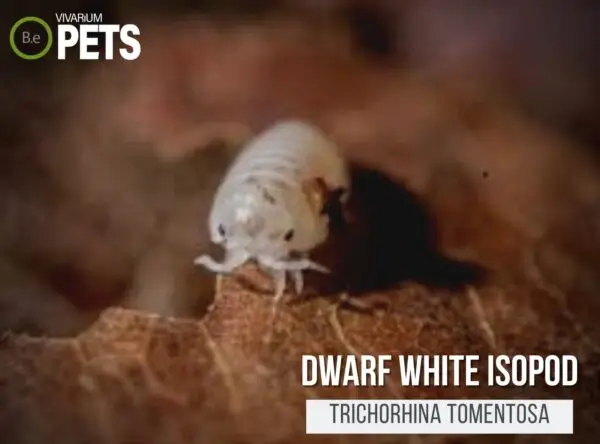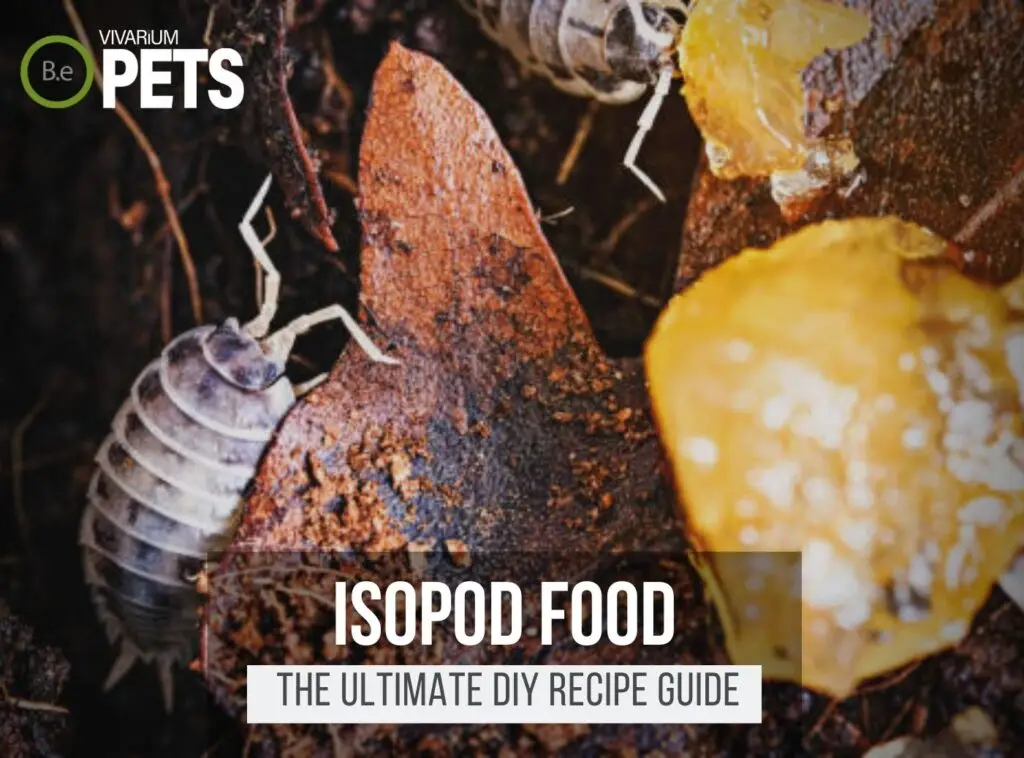Are you looking for an exciting pet that is both low-maintenance and enjoyable to watch? Consider owning Dwarf White Isopods (Trichorhina tomentosa)!
These small isopods are native to Central and South America and are extremely popular for terrariums, paludariums, and other micro-habitats.
Not only are these miniature isopods an attractive addition to any home, but they are easy to care for and require minimal supplies.
In this guide, we will take a closer look at everything you need to know about Trichorhina tomentosa care, from essential supplies to handling and breeding tips.
So, read on if you’re considering having these micro isopods around your home!
| Characteristics: | |
|---|---|
| Common Name | Dwarf White Isopods |
| Family Name | Armadillidae |
| Scientific Name | Trichorhina tomentosa |
| Use | Cleaning, Aerating Soil, Feeders |
| Temperament | Non-aggressive |
| Lifespan | 1-3 Years |
| Diet | Detritivore |
| Adult Size | 0.2-0.3 cm |
| Breeding Type | Egg Layer |
| Care Level | Easy |
| Minimum Tank Size | 2-5 Gallons |
| pH | 6.5-7.5 |
| Hardness | Soft |
| Temperature | 69-77°F |
Table Of Contents:
ToggleWhat Are Dwarf White Isopods?
Dwarf White Isopods, scientifically known as Trichorhina tomentosa, are small isopods that belong to the family Armadillidiidae.
Trichorhina tomentosa is among the smallest species of isopod available on the pet market.
They are native to Central and South America and thrive in terrariums, paludariums, and other similar humid and warm micro-habitats.
What Do Dwarf White Isopods Look Like?
Trichorhina tomentosa get their name from the fact that their miniaturized bodies are primarily white, but they may also have hues of yellow or beige.
Their dorso-ventrally flattened bodies are typically only 1 – 2 mm long, with 5 – 6 segments. Each segment also has two pairs of legs, making it easy for them to move around.
Dwarf White Isopods also have a smooth and slimy exterior, which helps them cling to surfaces and evade predators.
These isopods have long antennae, a pair of sharp claws, and two small eyes, which are all used to sense their environment.
Benefits Of Using Dwarf White Isopods
Dwarf White Isopods are an ideal addition to any vivarium due to their small size, hardy nature, and compatibility with other species.
Not only do they provide vital detritus, which helps cycle nutrients and maintain a balanced environment. They will also actively search for uneaten food, pick at live plants, and munch on any decaying organic matter they can find.
This helps keep the enclosure clean, aerate the substrate, and reduce the amount of work required of any clean-up crew.
Additionally, they can make a naturally stunning display when grouped in large numbers, which makes them a great aesthetic choice for the more avid design-focused pet owners.


Dwarf White Isopod Facts
Trichorhina tomentosa are naturally detrivores, meaning they prefer to feed on dead organic matter, decaying plants, and fungi.
They are generally docile in nature and with proper care, have a lifespan of up to 3 years, with breeding typically being initiated in the autumn or winter months.
Habitat
Dwarf White Isopods are native to wet, humid parts of Central and South America.
They inhabit damp leaf litter areas and thrive in tropical forests, savannas, and seasonal wetlands.
While they can also be found in many urban areas, they prefer more humid and dark places.
Diet
Dwarf White Isopods are detritivore feeders in the wild, eating a diet of both plant and animal matter.
In the wild, they may feed on decaying leaves and twigs, fungi, algae, and other organic matter. These Isopods are primarily scavengers, with their diet supplemented by the occasional insect.
Cathepsin, an enzyme found in the stomach of Isopods, is used to break down the cellulose found in decaying matter allowing the isopods to more easily gain nutrients.
Temperament
Dwarf White Isopods are not known to be aggressive and they generally remain very still in the presence of humans or other animals.
They remain calm and do not mind being handled by humans, as long as it’s done gently. Isopods are also quite shy and tend to hide when they feel threatened.
Overall, they are social animals that rarely cause distress or injury.
Dwarf White Isopods are also non-toxic and do not spread diseases to humans or other animals, making them a great choice for families with children or animals in the home.
Lifespan
Trichorhina tomentosa has a lifespan of up to three years or more in captivity.
While some species of Isopods have a slightly longer lifespan, Dwarf White Isopods are known for being particularly hardy and long-lived.
The life cycle of Dwarf White Isopods generally begins with an egg, which is normally white and long, and wrapped in a capsule.
When the egg hatches, the juvenile isopod is a miniature version of its adult form. The juvenile will usually molt a few times over the course of a few weeks before reaching its full adult size.
The adult Dwarf White Isopod will go through several more molts over its lifespan, in order to replace older, worn-out body parts.
Breeding
Dwarf White Isopods reproduce by creating an egg capsule, which is also referred to as an ootheca.
This capsule contains between 15-20 fertilized eggs. When the eggs are ready to hatch, they are gently pushed away from the female’s oothecae by adult members of the colony and hatch in their new environment.
Once they have hatched, the juveniles usually take 4-6 weeks to reach maturity, during which time they molt around 4-5 times.
Trichorhina tomentosa typically breed once a month and each female can lay up to five ootheca in her lifetime.
In order to successfully breed Dwarf White Isopods, it’s important to create an environment with the ideal temperature and humidity levels.
Additionally, it’s helpful to establish breeding pairs to ensure that the egg capsules are properly fertilized.
Where To Find Dwarf White Isopods
Dwarf White Isopods live predominantly on forest floors, where they feed on decaying matter. They can be found in wet moss and soil, as well as under logs and rocks.
In the wild, these isopods usually form small colonies of several dozen individuals.
If you’re interested in acquiring Dwarf White Isopods for your terrarium or micro-habitat, there are many online vendors you can purchase them from.
If possible, purchase Isopods that have already been raised together in a group rather than separately; this will help them acclimate to their new environment faster.
Dwarf White Isopod Care
Caring for Dwarf White Isopods requires a few essential supplies, such as good terrarium soil, basic lighting, and decor for hiding places. It is also vital to provide adequate temperature and humidity.
Nutrition and feeding should also be taken into account.
Handling and breeding should also be done with care and understanding of the species, as well as monitoring and maintaining a healthy environment.
Tank Requirements
Trichorhina tomentosa should always be kept in a well-ventilated terrarium that can provide adequate space for them to roam around.
The best type of vivarium for these isopods is a removable top or front-opening terrarium, as this provides more ventilation and will keep the humidity levels stable.
The ideal pH for Dwarf White Isopods should range between 6.2 and 7.5, and the water hardness should be 5 – 11 dGH.
The temperature of the tank should be kept between 76 and 86 degrees Fahrenheit, and the substrate should provide adequate drainage and ventilation, such as coconut fibers.
It is best to keep the tank out of direct sunlight and provide low levels of natural or terrarium lighting.
This will ensure the Dwarf White Isopods have a comfortable home and are properly able to move around the tank.
What Do Dwarf White Isopods Eat?
Feeding Dwarf White Isopods is relatively easy as they are omnivorous scavengers. To feed your isopods, you need to provide them with a variety of food sources.
Here are some items you can use to feed your Dwarf White Isopods:
- Vegetables such as cucumber, carrots, and mushrooms
- Fruits such as apples, bananas, and melons
- Shrimp pellets or other commercial isopod foods
- Leaf litter from a variety of trees and other plants
Always remember to offer your isopods a wide variety of food and to limit their intake.
If you’re more of an avid hobbyist like myself, be sure to check out my ultimate DIY Isopod food guide. I give a more in-depth explanation of the best foods and my personal favorite recipe.
Best Tankmates For Dwarf White Isopods
Trichorhina tomentosa is ideal for pet owners who want a low-maintenance pet.
As solitary creatures, it is best to keep Dwarf White Isopods in separate containers from other animals.
That said, there are a few other animals that can live in harmony with these types of isopods, making a fun and active terrarium possible.
The best tankmates for Dwarf White Isopods include snails, such as apple snails, Nerite snails, and Malaysian Trumpet snails.
Similarly, springtails are common and also great for creating a populated ecosystem.
These creatures share the same temperature and humidity needs as the White Isopods, so it is best to have them in the same enclosure.
Each of these animals will benefit from living among Dwarf White Isopods, keeping the soil healthy while they search for food and enjoy their natural habitats.
Finally, although Dwarf White Isopods are considered predators, they are gentle and will not harm their tankmates.
Conclusion
Overall, these miniature isopods make wonderful terrarium pets that require minimal care and maintenance.
Not only are they an attractive addition to any vivarium, but they can also be fun and fascinatingly interactive pets.
With the right supplies, a comfortable habitat, and good nutrition, your Trichorhina tomentosa can remain healthy and happy for years.
We hope you have enjoyed learning the basics of Dwarf White Isopod care and that it leaves you feeling more confident in caring for these wonderful creatures.
Frequently Asked Questions
Dwarf white isopods typically reach a size of 2 to 3 mm in length when fully grown.
The number of dwarf white isopods you need will depend on the size of your tank and the type of setup you have. Generally, it‘s recommended to start with at least 10–20 isopods in a 10–20 gallon tank.
Dwarf white isopods typically feed on decaying organic matter such as decaying leaves, wood, and vegetable matter. They may also feed on fungi, bacteria, and algae.
No, dwarf white isopods do not eat live plants. They are scavengers and primarily feed on decaying plant and animal matter.


